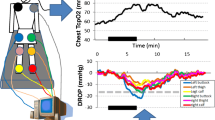Abstract
Foot and chest transcutaneous oxygen pressure (TcPO2), the regional perfusion index (RPI = foot TcPO2/chest TcPO2), and the ankle/brachial systolic blood pressure index (ABI) were calculated before and after successful percutaneous transluminal angioplasty (PTA) in 36 limbs with intermittent claudication and in 8 with rest pain. In patients affected by intermittent claudication pain-free (PFWT) and maximum walking times (MWT) and the half-recovery time (HRT) to TcPO2 basal values after an induced ischemia were also determined. After PTA, rest pain disappeared in the 8 severely ischemic lower limbs and significant differences were observed in the RPI, which increased by 215% from 0.19 ± 0.10 to 0.60 ± 0.13 (p<0.0001). In patients with intermittent claudication the RPI and the TcPO2 HRT in particular improved significantly (p<0.0001) (RPI: from 0.68 ± 0.18 to 0.85 ± 0.20; HRT: from 120 ± 27 to 75 ± 37 s). These modifications were associated, in the 24 patients who performed a standard treadmill test, with the disappearance of claudication or with a significant improvement in their walking capacity. The ABI was not calculated in 12 limbs because the arteries could not be compressed but it significantly improved in the other limbs in the stage II peripheral arterial occlusions disease (PAOD) patients.
These results indicate that substantial increases in TcPO2 parameters can be observed after successful PTA and that these measurements are an appropriate noninvasive method of assessing the results of revascularization procedures.
Similar content being viewed by others
References
Edwards EA (1959) Postamputation radiographic evidence for small artery obstruction in arteriosclerosis. Ann Surg 150:177–187.
Ehrly AM, Saeger Lorenz K (1987) Influence of pentoxifylline on muscle tissue oxygen tension (PO2) of patients with intermittent claudication before and after pedal ergometer exercise. Angiology 38:93–100.
Ferrier TM (1965) Vascular lesions in diabetes (letter to the editor). Br Med J 2:819.
Franzek UK, Talke P, Bernstein EF, et al. (1982) Transcutaneous PO2 measurements in health and peripheral arterial occlusive disease. Surgery 91:156–163.
Gannon MX, Goldman M, Simms MH, et al. (1986) Transcutaneous oxygen tension monitoring during vascular reconstruction. J Cardiovasc Surg 27:450–453.
Hauser CJ, Shoemaker WC (1983) Use of transcutaneous PO2 regional perfusion index to quantify tissue perfusion in peripheral vascular disease. Ann Surg 197:337–343.
Lorenten E (1973) Blood pressure and flow in the calf in relation to claudication distance. Scand J Lab Invest 31:141–146.
Mannarino E, Maragoni G, Pasqualini L, et al. (1987) Transcutaneous oxygen tension behavior in the different stages of peripheral vascular disease and its correlation with ankle/arm pressure ratio and calf blood flow. Angiology 38:463.
Mannarino E, Pasqualini L, Maragoni G, et al. (1988) Chronic venous incompetence and transcutaneous oxygen pressure: Controlled study. Vasa 17:159–161.
Mannarino E, Pasqualini L, Maragoni G, et al. (1989) Effect of buflomedil chlorhydrate on local oxygen delivery in peripheral vascular disease. Angiology 40:559–562.
Osmundson PJ, Cheseboro JH, O'Fallon WM, et al. (1981) A prospective study of peripheral occlusive arterial disease in diabetes. II Vascular laboratory assessment. Mayo Clin Proc 56:223–232.
Osmundson PJ, Rooke TW, Hallet JW (1988) Effect of arterial revascularization on transcutaneous oxygen tension of the ischemic extremity. Mayo Clin Proc 63:897–902.
Sasaki H (1980) A plantar ischemia test after walking as an index of walking exercise in the patients with Buerger's disease. J Jpn Coll Angiol 20:873–878.
Wyss CR, Matsen FA III, Simmons CW, et al. (1984) Transcutaneous oxygen tension measurements on limbs of diabetic and nondiabetic patients with peripheral vascular disease. Surgery 95:339–345.
Author information
Authors and Affiliations
About this article
Cite this article
Mannarino, E., Pasqualini, L., Innocente, S. et al. Modifications in transcutaneous oxygen pressure in ischemic limbs after successful PTA. International Journal of Angiology 3, 113–115 (1994). https://doi.org/10.1007/BF02014925
Issue Date:
DOI: https://doi.org/10.1007/BF02014925




